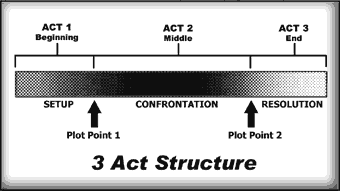Video Production
2.2 How are Fictional Films Structured?
The overall structure of fictional films
Most fiction films have distinct beginnings, middles and ends. These are often broken up into Act One, Act Two and Act Three - a three-act structure. In fact these acts are often so distinct that you can spot where each of these acts start and finish. The three-act theory (which most Hollywood films fall into, for example) state that in the first act you should establish your characters and the issue they face. The second act should involve a conflict and its outcome. The third and shortest act resolves all the loose ends and allows the audience "closure".

Act Structure
Using an example of a 30 minute video, (30 minutes of screen time) the script should be roughly 30 pages long. This is because it is generally assumed that one page of script roughly equals one minute of screen time. If we split the script up into the three acts, the beginning of the film (Act One) should take up a little less than ten minutes, the middle of the film (Act Two) should run just over ten minutes and the end of the film (Act Three) should be the last five to ten minutes.
Each scene within the acts should be a mini version of the three-act theory explained as follows. It should have a beginning, an issue and a resolution although it may leave some loose ends to be resolved after; the tension that occurs when two characters fight over an issue is called dramatic tension and greatly increases the interest, most soaps are based on this alone.
Act 1 - Setup
This first section is the setup, it has to lay the groundwork for the story and answer three questions:
1) Who’s this film about? Who is the lead character? What kind of person are they? Usually we are introduced to the characters and see what they do day to day. We are encouraged to identify with the characters and like them.
2) Where’s it taking place? What’s the story’s location? What kind of world do the characters live in?
3) What’s going to happen? Something is going to happen that is going to challenge the lead character.
Plot Point 1 - At the end of Act One comes the first plot point. A plot point is a hook in the action that spins it around and creates direction. Something happens that sets the course for the rest of the movie - e.g. the aliens invade or a body is found. Now the characters know their purpose; to fight back against the aliens or discover who the murderer is, and that’s what they’ll spend Act Two doing.
Act 2 - Confrontation
By this point, your character should have a dramatic need: to find the murderer, or some other task or mission to fulfil. But it wouldn’t make a good story if they could complete their task straight away. Conflict is the essence of drama. The character has to overcome a series of obstacles that you drop in their path. Act Two is the biggest section to write (which can be around 60 pages long in a feature length film!).
Plot Point 2 - At the end of Act Two comes the second plot point. Now the character has been moving towards their goal and it’s usually by now that the solution is in sight. It may not be easy to achieve, but they know what they have to do. Usually it’s just before plot point 2 that all the really bad things happen. One minute it seems the ‘hero’ is about to achieve their goal, only to suddenly be imprisoned, or a colleague/loved one may get shot for example. Now the lead character’s efforts have to be redoubled.
Act 3 - Resolution
Everything should be in place for the finale; all the plot threads and characterisation that have been building up in Acts One and Two can be used for dramatic effect and released and resolved in Act Three. By Plot Point 2 the main character knows what needs to be done so Act Three is spent planning and getting into a position of strength, mostly carrying out the action and finally enjoying the aftermath and seeing who gets to ride off with who into the sunset. The ‘hero’ realises the final task that must be completed, carries it out and most (if not all) loose ends in the plot are tied up.
Even with a structure in place, you still need to use your creativity and talent to fill in the characters and story. This system of structuring helps to break the task up into chunks: a series of smaller tasks to be tackled. With the basic structure of your film mapped out you can concentrate on telling the story, building characters and writing dialogue.
The three-act structure is vital for short fictional films as well as full-length features - it can fit almost any fictional piece, however long or short - even if your video is only five or ten minutes long, this structure can still be applied. For some examples of fictional community videos and where you can see them on the Internet, see the appendix.